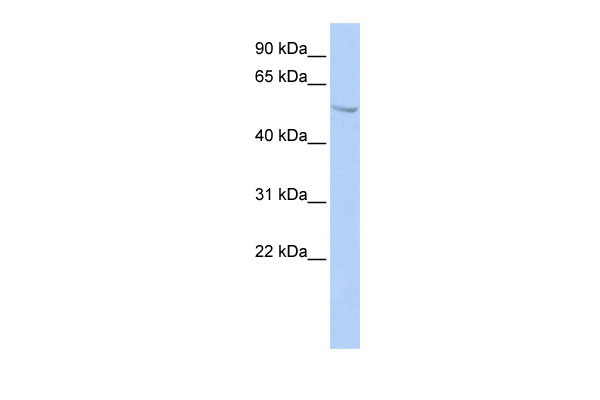SUFU antibody - N-terminal region
Rabbit Polyclonal Antibody
- SPECIFICATION
- CITATIONS
- PROTOCOLS
- BACKGROUND

Application
| WB |
|---|---|
| Primary Accession | Q9UMX1 |
| Other Accession | NM_016169, NP_057253 |
| Reactivity | Human, Mouse, Rat, Zebrafish, Pig, Horse, Bovine, Dog |
| Predicted | Human, Mouse, Rat, Zebrafish, Pig, Chicken, Bovine, Dog |
| Host | Rabbit |
| Clonality | Polyclonal |
| Calculated MW | 54kDa |
| Gene ID | 51684 |
|---|---|
| Alias Symbol | PRO1280, SUFUH, SUFUXL |
| Other Names | Suppressor of fused homolog, SUFUH, SUFU |
| Format | Liquid. Purified antibody supplied in 1x PBS buffer with 0.09% (w/v) sodium azide and 2% sucrose. |
| Reconstitution & Storage | Add 50 ul of distilled water. Final anti-SUFU antibody concentration is 1 mg/ml in PBS buffer with 2% sucrose. For longer periods of storage, store at 20°C. Avoid repeat freeze-thaw cycles. |
| Precautions | SUFU antibody - N-terminal region is for research use only and not for use in diagnostic or therapeutic procedures. |
| Name | SUFU {ECO:0000303|PubMed:12068298, ECO:0000312|HGNC:HGNC:16466} |
|---|---|
| Function | Negative regulator in the hedgehog/smoothened signaling pathway (PubMed:10559945, PubMed:10564661, PubMed:10806483, PubMed:12068298, PubMed:12975309, PubMed:27234298, PubMed:15367681, PubMed:22365972, PubMed:24217340, PubMed:24311597, PubMed:28965847). Down-regulates GLI1-mediated transactivation of target genes (PubMed:15367681, PubMed:24217340, PubMed:24311597). Down-regulates GLI2-mediated transactivation of target genes (PubMed:24311597, PubMed:24217340). Part of a corepressor complex that acts on DNA-bound GLI1. May also act by linking GLI1 to BTRC and thereby targeting GLI1 to degradation by the proteasome (PubMed:10559945, PubMed:10564661, PubMed:10806483, PubMed:24217340). Sequesters GLI1, GLI2 and GLI3 in the cytoplasm, this effect is overcome by binding of STK36 to both SUFU and a GLI protein (PubMed:10559945, PubMed:10564661, PubMed:10806483, PubMed:24217340). Negative regulator of beta-catenin signaling (By similarity). Regulates the formation of either the repressor form (GLI3R) or the activator form (GLI3A) of the full-length form of GLI3 (GLI3FL) (PubMed:24311597, PubMed:28965847). GLI3FL is complexed with SUFU in the cytoplasm and is maintained in a neutral state (PubMed:24311597, PubMed:28965847). Without the Hh signal, the SUFU- GLI3 complex is recruited to cilia, leading to the efficient processing of GLI3FL into GLI3R (PubMed:24311597, PubMed:28965847). When Hh signaling is initiated, SUFU dissociates from GLI3FL and the latter translocates to the nucleus, where it is phosphorylated, destabilized, and converted to a transcriptional activator (GLI3A) (PubMed:24311597, PubMed:28965847). Required for normal embryonic development (By similarity). Required for the proper formation of hair follicles and the control of epidermal differentiation (By similarity). |
| Cellular Location | Cytoplasm. Nucleus |
| Tissue Location | Ubiquitous in adult tissues. Detected in osteoblasts of the perichondrium in the developing limb of 12-week old embryos. Isoform 1 is detected in fetal brain, lung, kidney and testis Isoform 2 is detected in fetal testis, and at much lower levels in fetal brain, lung and kidney. |

Thousands of laboratories across the world have published research that depended on the performance of antibodies from Abcepta to advance their research. Check out links to articles that cite our products in major peer-reviewed journals, organized by research category.
info@abcepta.com, and receive a free "I Love Antibodies" mug.
Provided below are standard protocols that you may find useful for product applications.
References
Lee,D.Y., (2007) Proc. Natl. Acad. Sci. U.S.A. 104 (51), 20350-20355 Reconstitution and Storage:For short term use, store at 2-8C up to 1 week. For long term storage, store at -20C in small aliquots to prevent freeze-thaw cycles.
If you have used an Abcepta product and would like to share how it has performed, please click on the "Submit Review" button and provide the requested information. Our staff will examine and post your review and contact you if needed.
If you have any additional inquiries please email technical services at tech@abcepta.com.













 Foundational characteristics of cancer include proliferation, angiogenesis, migration, evasion of apoptosis, and cellular immortality. Find key markers for these cellular processes and antibodies to detect them.
Foundational characteristics of cancer include proliferation, angiogenesis, migration, evasion of apoptosis, and cellular immortality. Find key markers for these cellular processes and antibodies to detect them. The SUMOplot™ Analysis Program predicts and scores sumoylation sites in your protein. SUMOylation is a post-translational modification involved in various cellular processes, such as nuclear-cytosolic transport, transcriptional regulation, apoptosis, protein stability, response to stress, and progression through the cell cycle.
The SUMOplot™ Analysis Program predicts and scores sumoylation sites in your protein. SUMOylation is a post-translational modification involved in various cellular processes, such as nuclear-cytosolic transport, transcriptional regulation, apoptosis, protein stability, response to stress, and progression through the cell cycle. The Autophagy Receptor Motif Plotter predicts and scores autophagy receptor binding sites in your protein. Identifying proteins connected to this pathway is critical to understanding the role of autophagy in physiological as well as pathological processes such as development, differentiation, neurodegenerative diseases, stress, infection, and cancer.
The Autophagy Receptor Motif Plotter predicts and scores autophagy receptor binding sites in your protein. Identifying proteins connected to this pathway is critical to understanding the role of autophagy in physiological as well as pathological processes such as development, differentiation, neurodegenerative diseases, stress, infection, and cancer.


